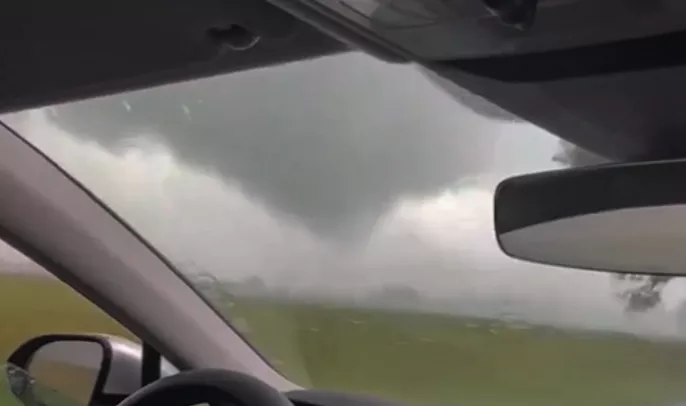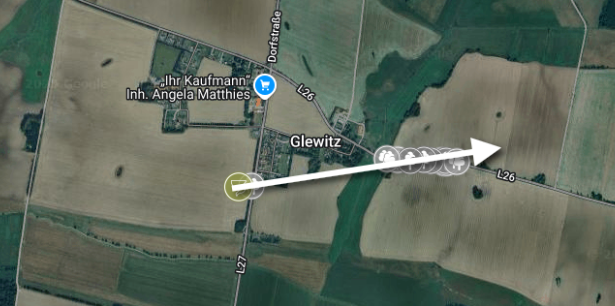
In June 2025, Europe experienced a notable uptick in tornado activity, underscoring the continent’s vulnerability to severe convective weather. While tornadoes in Europe are generally less frequent and less intense than those in the United States, the events of this June highlight a concerning trend of increased occurrence and intensity.
June 5 – IF0 Tornado
- Location: Ter Apel, Groningen, Netherlands
- Details: Weak tornado that broke off small branches. Rated IF0
June 7 – IF1 Tornado
- Location: Glewitz area, Mecklenburg‑Vorpommern, Germany
- Details: Path length ~1.3 km with tree damage; video confirmed by local fire brigade. Rated IF1
June 8 – Waterspout
- Location: Vejby Strand, Gribskov Kommune, Denmark
- Details: Funnel observed over water from nearby beach. Rated waterspout under QC1
Jun 7 – Šakiai District, Lithuania
- A tornado (IF1?) struck the Šakiai District in southwestern Lithuania on June 7, 2025. Winds reached about 120 km/h. No injuries or major structural damage were reported
📊 Summary Table: Tornado Events in Europe in June 2025, so far
| Date | Country | Location | Intensity (IF Scale) | Path Length | Key Impacts |
|---|---|---|---|---|---|
| June 1 | France | Saint‑Bonnet‑le‑Courreau → Bard | IF2 | ≥14 km, ~500 m wide | Roofs destroyed, trees uprooted, 1 injury |
| June 5 | Serbia | Vršac, South Banat | IF0.5 | Not listed | Large branches broken |
| June 5 | Netherlands | Ter Apel, Groningen | IF0 | Not listed | Small branches broken |
| June 7 | Germany | Glewitz area, Mecklenburg‑Vorpommern | IF1 | ~1.3 km | Tree damage, confirmed by fire brigade & video |
| June 7 | Lithuania | Šakiai District | IF1? | Not listed | Uprooted trees, winds ~120 km/h, no major damage |
| June 8 | Denmark | Vejby Strand (Gribskov Kommune, Zealand) | Waterspout (IF?) | Not listed | Funnel observed over sea surface |
Tornadoes in Europe: Patterns, Hotspots, and Seasonality
Overview
Unlike the United States, Europe experiences fewer and generally weaker tornadoes, but they still pose significant risks. Tornadoes occur every year across much of Europe, from the Mediterranean basin up to the northern countries, with varying intensity and frequency.
Regional Hotspots
- Central and Eastern Europe
This region, including countries like Germany, Poland, Czechia, Slovakia, Hungary, and parts of Serbia and Romania, is a well-known hotspot for tornadoes. It experiences the highest frequency of confirmed tornadoes in Europe, especially during the warmer months. The combination of continental air masses, the Carpathian Mountains, and frequent frontal systems creates favorable conditions. - Southern Europe and the Mediterranean
Tornadoes occur regularly in Italy, France, Spain, and Greece. Coastal and inland areas alike see tornadoes, often associated with severe thunderstorms or waterspouts that sometimes move onshore. Tornadoes here tend to be shorter-lived but occasionally intense. - Northern and Western Europe
While less frequent, tornadoes do occur in countries such as the United Kingdom, the Netherlands, Belgium, Denmark, and southern Scandinavia. Waterspouts are more common near coastal waters, but land tornadoes—usually weaker—are documented. - Baltic States and Scandinavia
Tornadoes here are rarer but have been increasingly reported thanks to better monitoring and public awareness. Events in Lithuania, Latvia, and southern Sweden show that northern Europe is not exempt.
Seasonality: When Do Tornadoes Peak?
- Late Spring to Early Summer (May to July)
The tornado season in Europe usually peaks between May and July. This period sees the highest incidence of severe convective storms fueled by strong solar heating and increased atmospheric instability. - Secondary Peak in Autumn
Some regions, especially southern Europe, can experience a secondary peak during September and October, linked to transitional season weather patterns. - Early Summer Tornadoes
Tornadoes in June, like those reported in early June 2025, align well with the peak season. This period sees a maximum in convective available potential energy (CAPE) and frequent frontal boundaries leading to severe thunderstorms.
Typical Characteristics of European Tornadoes
- Intensity: Most European tornadoes are weak to moderate, ranging from IF0 to IF2 on the International Fujita scale. Stronger tornadoes (IF3 and above) are rare but have been recorded in countries like France, Italy, and Poland.
- Path Length and Width: Tornado tracks usually range from a few hundred meters up to several kilometers. The wider and longer-tracked tornadoes mostly occur in central Europe.
- Damage: Tree damage, roof loss, overturned vehicles, and damaged power lines are common impacts. Casualties are rare but possible, especially from stronger tornadoes.
Trends and Monitoring
- Improved Reporting
Thanks to European Severe Weather Database (ESWD) and modern technology (satellite, radar, social media), tornado detection and reporting have improved dramatically, resulting in more frequent confirmations and better understanding. - Climate Influence
Climate change might be influencing tornado frequency and intensity in Europe by altering atmospheric instability and storm dynamics, but scientific consensus is still evolving.
Summary
| Aspect | Details |
|---|---|
| Peak Tornado Season | May to July (primary), September to October (secondary) |
| Main Tornado Regions | Central/Eastern Europe, Southern Europe, parts of Western/Northern Europe |
| Typical Intensity | IF0 to IF2 (weak to moderate) |
| Common Impacts | Tree damage, roof damage, power line disruption |
| Notable Rare Events | Occasional IF3+ tornadoes in France, Italy, Poland, Czechia |
| Monitoring | ESWD, radar, public reports, social media |


Source: https://www.torkud.de/post/vglewitz25/
EF1 tornado in Glewitz, Germany on June 7th, around 16:40. Source: https://eswd.eu/cgi-bin/eswd.cgi

Tornado in Keturnaujiena, Lithuania, on June 7th around 18:33


























